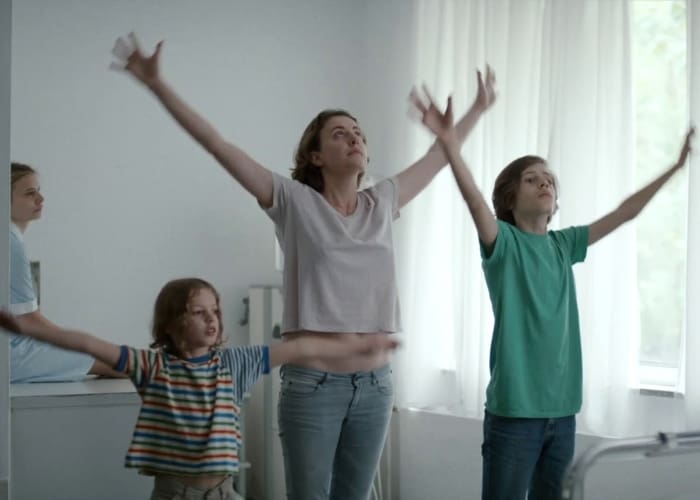Angela Schanelec‘s latest film I Was At Home, But… promises a mysterious family drama that sounds like an intriguing story. A 13-year-old boy returns home from wandering in the woods for a week to a mother who is still grieving her husband’s death. While the circumstances could lay the groundwork for a film seething with tension, it has no bearing on most of the scenes, and what the audience is left with are more confusions than statements.
The film opens with three animals in the wild: a wolf, a rabbit, and a donkey. The camera sits still in an abandoned house as the wolf eats the rabbit it had been chasing and the donkey walks in and out of frame. Nothing they do is telling the audience anything in particular; they’re simply existing and we’re watching it happen. The rest of the film follows the same kind of wordless wandering except it isn’t animals we’re watching, it’s people who are fully capable of articulating what is going on inside them.
What the film is supposed to be about, the return of young boy Phillip (Jakob Lassalle) after he was missing for a week, is never spoken about for at least 20 minutes into the film. We see him walk calmly into an office, wearing a dirty jacket and covered in sweat. When his mother Astrid (Maren Eggert) runs to him, neither of them say anything at all. If you didn’t read the logline before seeing the film you’d have no idea he ran away for a week. There are no tears from either of them or any indication of what anyone is feeling. It remains that way throughout the entire film.
It’s hard to appreciate the several beautiful images that Schanelec shows on screen when you’re so busy mining for any kind of meaning in every single scene. This film seems like the kind that wants to make its audience question their own lives, but without a solid understanding of the lives on screen it is impossible to connect with the film at all. Astrid’s character is thoroughly confusing. She tries to go along with her life like nothing is wrong. She tells her son’s teachers that he is fine and ready to be back in school. Even when she begs them to stop talking about him like there’s something wrong with him, there is no emotion in her voice. The first thing we see her do after her child has gone missing for a week is buy a bike then return that bike, but not without a 15-minute argument about returning it. Throughout the scenes where we expect her to show some kind of response to what’s going on in her life, she does nothing. She never mentions her husband’s death until far into the film, so there’s no way of telling what she isn’t articulating out loud.
The performances are almost a parody of what Americans who don’t watch foreign cinema expect from a German film. Kids stand utterly silent looking away from the people they talk to. They don’t ask questions about what’s going on as kids would do. Their class performance of Hamlet is as expressionless and droll as the rest of the film. People don’t even seem to register any thoughts on their faces as the camera stays on them for minutes on end in utter silence.
A film like this could be beautiful, yet it lacks the contemplation that a slow and stoic film needs in order to have any effect on an audience. It doesn’t ask questions of existence or relationships or human nature in the dialogue. It certainly doesn’t show the characters acting in a way that makes the audience think about anything else but trying to figure out what they’re supposed to be getting from the scene. Every time the film has a chance to give us the emotions we crave to understand the film’s message, it backs away and jumps to a completely unrelated scene. The most emotion we see is when Astrid throws her children out of their apartment for laughing in their bedroom while she eats breakfast with a lover in silence. She screams at Phillip, who is still wrapping a wound on his foot and walking with crutches from when he went missing in the woods. It’s as if the event that was supposed to incite this entire film into motion has no effect on how she treats those around her. The boyfriend leaves and gives her kids high-fives as they sit outside the apartment building, and the next scene doesn’t address what happened between them at all.
Astrid’s actions and words never elicit any reaction from the people around her, so the audience feels unmoved by her as well. There seem to be no consequences for how she copes with her life as it is. Why are we observing this story if it has no bearing on the people in the film? Films with little to no dialogue can work, but there needs to be emotion in the images we see on screen and the faces of the characters that can do the talking. The camera can focus on a static scene if what we hear is invoking some sort of thought, like an interesting conversation or a voice-over. I Was At Home, But… holds static, unmoving images and painful silence at the same time for most of the film, giving the audience absolutely nothing to go off of when experiencing this film. While there are plenty of slow-moving films that hold the most profound of emotions, this is not that kind of film.

